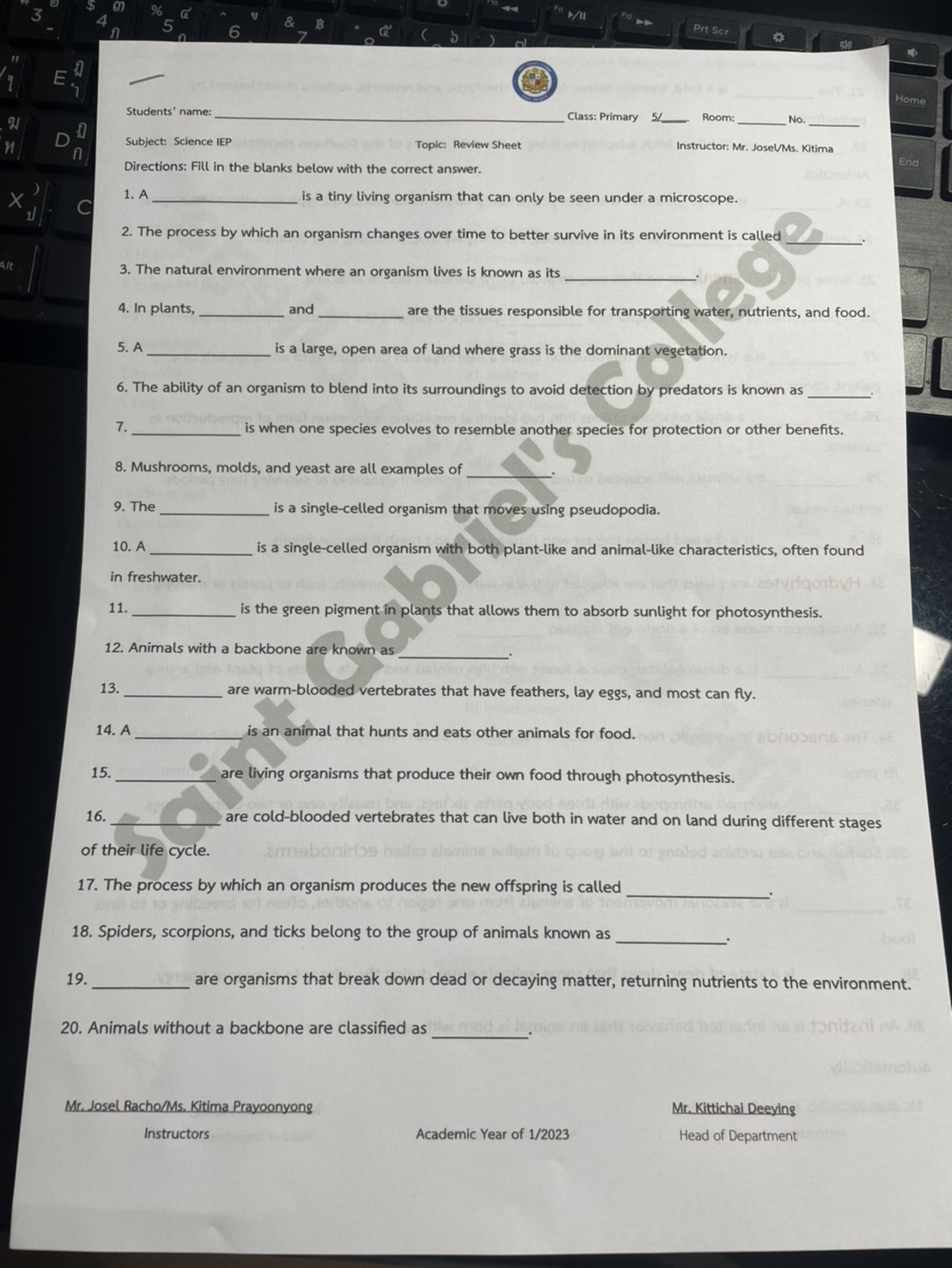Fill in the blanks with the correct answer about living organisms and their classifications.

Understand the Problem
The question is asking to fill in the blanks in a review sheet focused on science topics related to living organisms, their environments, and classifications. It aims to assess understanding of key concepts in biology.
Answer
1. microorganism, 2. evolution, 3. habitat, 4. xylem, phloem, 5. savanna, 6. camouflage, 7. mimicry, 8. fungi, 9. amoeba, 10. euglena, 11. chlorophyll, 12. vertebrates, 13. birds, 14. carnivore, 15. plants, 16. amphibians, 17. reproduction, 18. arachnids, 19. decomposers, 20. invertebrates.
["1. A microorganism is a tiny living organism that can only be seen under a microscope.","2. The process by which an organism changes over time to better survive in its environment is called evolution.","3. The natural environment where an organism lives is known as its habitat.","4. In plants, xylem and phloem are the tissues responsible for transporting water, nutrients, and food.","5. A savanna is a large, open area of land where grass is the dominant vegetation.","6. The ability of an organism to blend into its surroundings to avoid detection by predators is known as camouflage.","7. Mimicry is when one species evolves to resemble another species for protection or other benefits.","8. Mushrooms, molds, and yeast are all examples of fungi.","9. The amoeba is a single-celled organism that moves using pseudopodia.","10. A euglena is a single-celled organism with both plant-like and animal-like characteristics, often found in freshwater.","11. Chlorophyll is the green pigment in plants that allows them to absorb sunlight for photosynthesis.","12. Animals with a backbone are known as vertebrates.","13. Birds are warm-blooded vertebrates that have feathers, lay eggs, and most can fly.","14. A carnivore is an animal that hunts and eats other animals for food.","15. Plants are living organisms that produce their own food through photosynthesis.","16. Amphibians are cold-blooded vertebrates that can live both in water and on land during different stages of their life cycle.","17. The process by which an organism produces the new offspring is called reproduction.","18. Spiders, scorpions, and ticks belong to the group of animals known as arachnids.","19. Decomposers are organisms that break down dead or decaying matter, returning nutrients to the environment.","20. Animals without a backbone are classified as invertebrates."]
Answer for screen readers
["1. A microorganism is a tiny living organism that can only be seen under a microscope.","2. The process by which an organism changes over time to better survive in its environment is called evolution.","3. The natural environment where an organism lives is known as its habitat.","4. In plants, xylem and phloem are the tissues responsible for transporting water, nutrients, and food.","5. A savanna is a large, open area of land where grass is the dominant vegetation.","6. The ability of an organism to blend into its surroundings to avoid detection by predators is known as camouflage.","7. Mimicry is when one species evolves to resemble another species for protection or other benefits.","8. Mushrooms, molds, and yeast are all examples of fungi.","9. The amoeba is a single-celled organism that moves using pseudopodia.","10. A euglena is a single-celled organism with both plant-like and animal-like characteristics, often found in freshwater.","11. Chlorophyll is the green pigment in plants that allows them to absorb sunlight for photosynthesis.","12. Animals with a backbone are known as vertebrates.","13. Birds are warm-blooded vertebrates that have feathers, lay eggs, and most can fly.","14. A carnivore is an animal that hunts and eats other animals for food.","15. Plants are living organisms that produce their own food through photosynthesis.","16. Amphibians are cold-blooded vertebrates that can live both in water and on land during different stages of their life cycle.","17. The process by which an organism produces the new offspring is called reproduction.","18. Spiders, scorpions, and ticks belong to the group of animals known as arachnids.","19. Decomposers are organisms that break down dead or decaying matter, returning nutrients to the environment.","20. Animals without a backbone are classified as invertebrates."]
More Information
These answers cover the fundamental concepts of organisms' classifications and characteristics in the fields of biology and ecology.
Tips
Ensure the context of each blank is understood before filling it in. Common mistakes include confusing similar terms like xylem and phloem or not distinguishing between vertebrates and invertebrates.
Sources
AI-generated content may contain errors. Please verify critical information